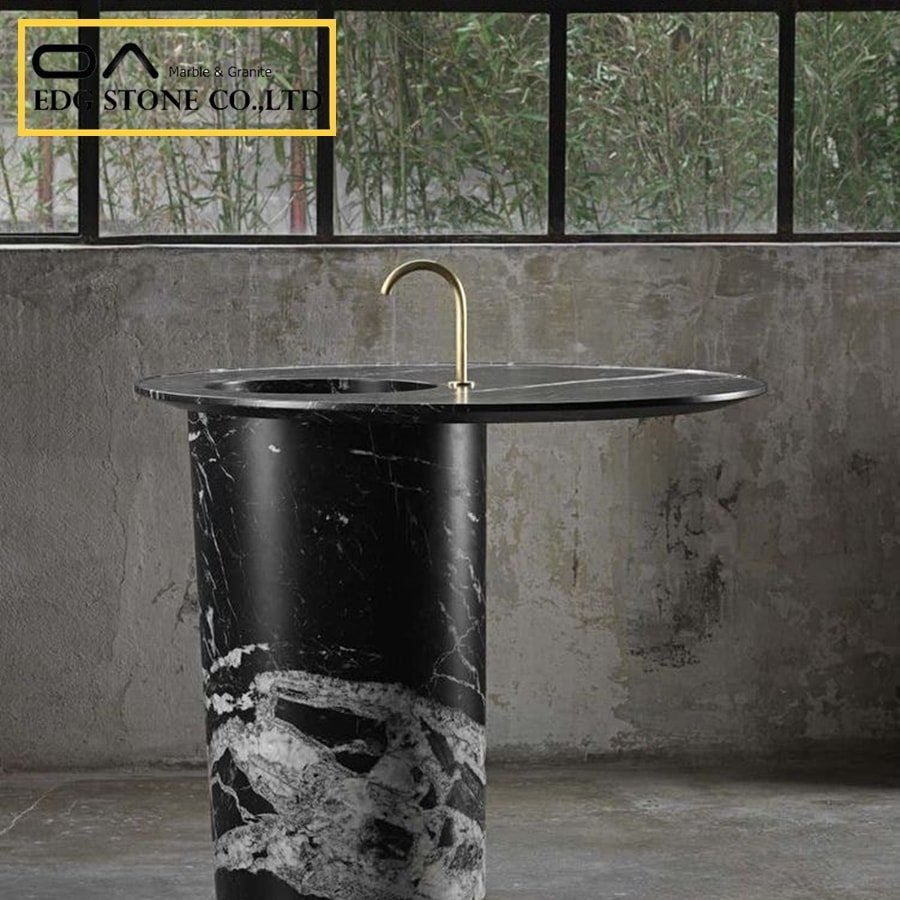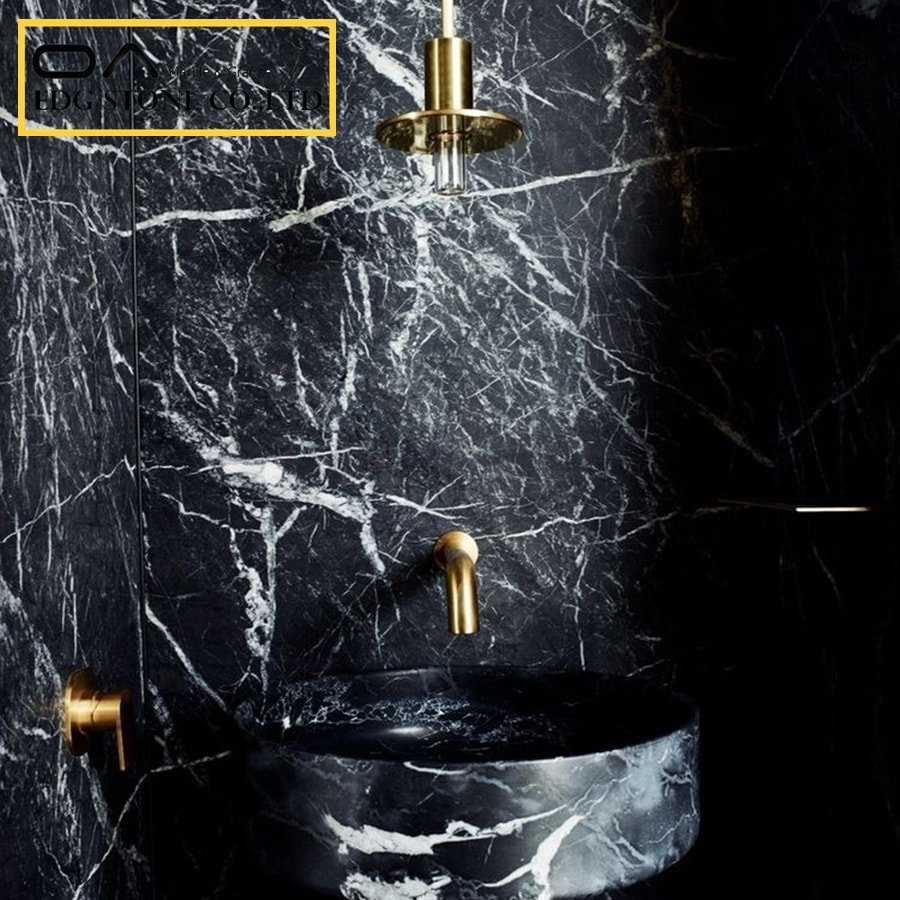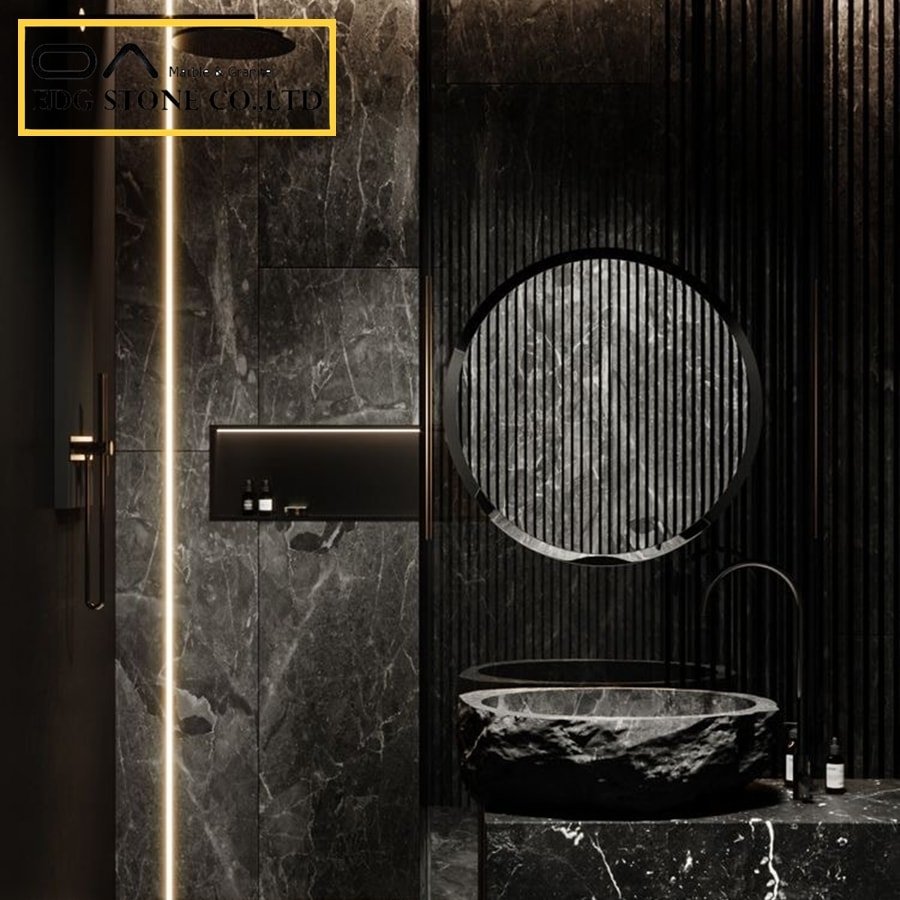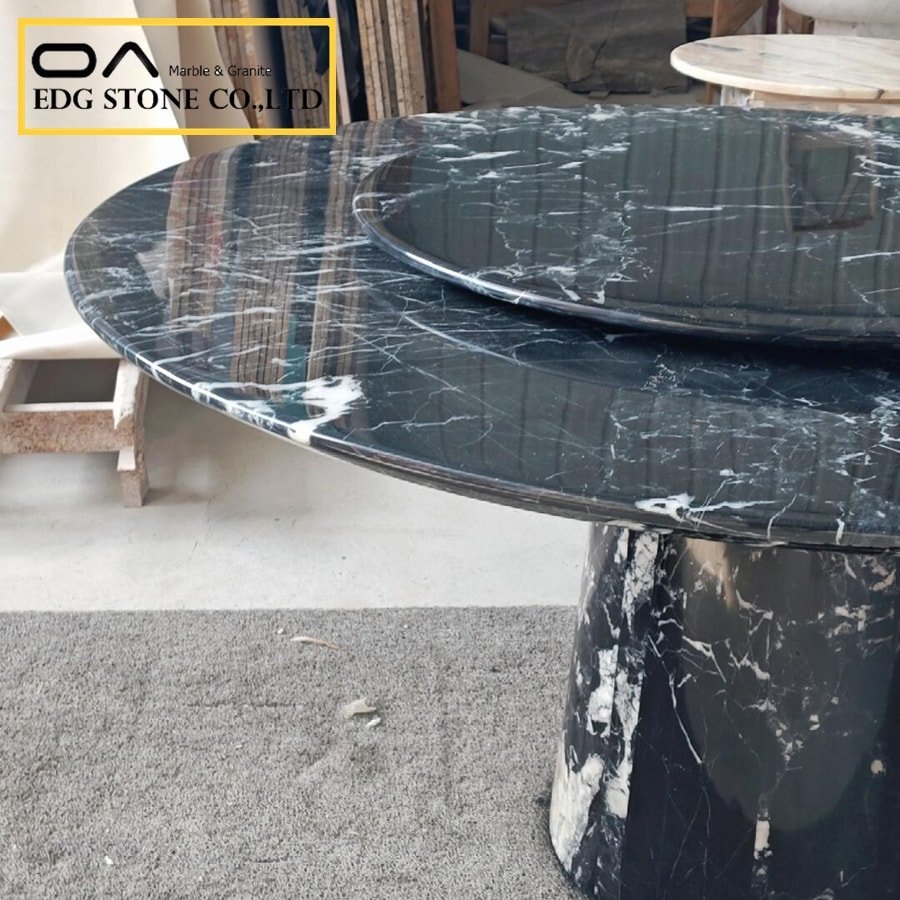

What is black marble — geological definition and composition?
Table of Contents
Toggle- What is black marble — geological definition and composition?
- Common types and origins — Nero Marquina, Portoro, and others
- What is black marble made of — composition & properties
- What is the price of black marble — ballpark ranges & factors
- What is black marble used for? (applications)
- How to clean black marble — practical, AI-extractable steps
- How to choose a finish — polished, honed, leathered
- Buying black marble — manufacturer/factory / wholesale tips
- Safety & regulation — silica, VOCs, and industry trends
- EDG Stone’s black marble — why recommend it?
- Maintenance schedule — keep black marble beautiful
- Long-tail keyword list (3–5 purchase intent examples)
- FAQ — Google hot-search style (5 items)
- Focus keyword, meta, URL slug, and 50 SEO tags
- References & authoritative sources (selected)
Black marble is marble in the stonemasonry sense — a metamorphic rock formed from limestone or dolomite that has recrystallized under heat and pressure into calcite or dolomite crystals. Its black color results from organic bitumen, carbonaceous matter, or mineral impurities within the protolith; sometimes fossil content or bituminous materials create dramatic backgrounds and veining. In geological terms, marble’s primary mineral is calcite (CaCO₃) or, less commonly, dolomite (CaMg(CO₃)₂). 維基百科
Key takeaway: black marble = metamorphosed carbonate rock with dark coloration from organics/minerals; chemically, it’s mostly calcite/dolomite, so it reacts with acids (etching risk).
Common types and origins — Nero Marquina, Portoro, and others
Nero Marquina (Spain) — one of the most recognized black marbles, quarried in the Basque region (Markina). It has a deep black ground with striking white veins and is widely used for tiles, slabs, and architectural features. 維基百科blok.com.br
Portoro / Portoro di Torre (Italy) — black with golden or white veining; highly prized and typically more expensive.
Black fossil marbles — containing visible fossil remains that add texture and pattern.
Black limestones marketed as marble — note that trade usage sometimes labels dark limestones or bituminous limestones as “black marble”; check geological provenance if you need true metamorphic marble.
Where black marble comes from: Spain, Italy, parts of Turkey, and other European/Asian quarries are notable sources for premium black marbles; provenance affects veining, color uniformity, and price.


What is black marble made of — composition & properties
Mineralogy: primarily calcite (CaCO₃) or dolomite; trace minerals and organics produce color and veins. 維基百科
Porosity & hardness: marble is softer and more porous than granite; it polishes to a high sheen but is more susceptible to acid etching and surface wear.
Thermal & mechanical: suitable for interior use; for countertop kitchens, consider maintenance tradeoffs (polished elegance vs. etched risk).
What is the price of black marble — ballpark ranges & factors
Prices vary strongly by variety, finish, slab size, and origin:
Retail tile samples/budget tiles: modest cost per sq ft, depending on finish and thickness. (Example: Nero Marquina tiles sold by established tile vendors — product pages show per-sq-ft pricing for honed/polished tiles).
Full slabs (2 cm/3 cm): entry-to-mid ranges may start around tens of dollars per sq ft; premium Portoro or bookmatched slabs can run substantially higher. Example listing: a 2 cm Nero Marquina slab priced around $53 / sq ft (sample vendor listing) — but prices vary by supplier, freight, and fabrication. (Use slab quotes from multiple distributors for current market pricing.)
Factors that affect price: scarcity of quarry, slab yield and bookmatching potential, degree of veining/patterning, finish (polished/honed/leathered), fabrication complexity (sink cutouts, edge profiles), and shipping/import logistics.

What is black marble used for? (applications)
Countertops & vanities (bathroom and low-traffic kitchens when chosen carefully)
Wall cladding and fireplace surrounds
Flooring in entrances and showrooms (hon carefully selected finishes to reduce slip)
Decorative furniture tops, tabletops, and sculptural pieces
Design note: polished black marble creates dramatic reflections and high contrast — great for luxury interiors — while honed or leathered finishes are more forgiving in high-use areas.
How to clean black marble — practical, AI-extractable steps
Black marble care revolves around avoiding acids and abrasives and using neutral products.
Daily cleaning quick steps:
Blot spills immediately — do not rub.
Wipe with warm water + a few drops of mild dish soap or a pH-neutral stone cleaner. Rinse and dry with a soft microfiber cloth. (Natural Stone Institute recommends neutral cleaners intended for natural stone.)
Avoid vinegar, lemon, bleach, ammonia, or abrasive pads — these cause etching or surface damage.
Deep clean & stain removal (overview):
Oil stains: baking soda poultice (paste with water), covered with plastic, left 24–48 hours, then cleaned.
Organic stains (wine, coffee): peroxide-based poultices or commercial organic stain poultices (test first, especially on dark stones).
Etches (acid damage): not a surface deposit — light etches can be improved with marble polishing powder; deeper etches require professional honing/polishing.
How to choose a finish — polished, honed, leathered
Polished: maximum gloss, shows etches and fingerprints the most.
Honed: matte, hides etches better — good for kitchens.
Leathered: textured, hides wear and fingerprints while keeping depth.
For kitchens or high-use counters, consider honed/leathered for practicality; for vanities or feature walls, polished black marble creates a luxury effect.

Buying black marble — manufacturer/factory / wholesale tips
Request full-slab photos or visit the yard — veining and color vary slab to slab.
Ask for finish samples (polished/honed/leathered) to see the real-world appearance.
Check SDS and fabrication guidance to ensure your fabricator follows silica safety and wet-cutting protocols.
Get multiple wholesale/manufacturer quotes for slab + fabrication + install; compare seam layout and edge profile options before final purchase. For large projects, ask suppliers for lead times and shipping logistics.
Long-tail purchase keywords to target:
best black marble slab manufacturer wholesale
where to buy Nero Marquina slabs factory
black marble slab supplier bulk price
Safety & regulation — silica, VOCs, and industry trends
Respirable crystalline silica (RCS): Cutting, grinding, and polishing marble and engineered stone can release respirable crystalline silica. OSHA’s silica standards and guidance require exposure controls such as wet cutting, local exhaust ventilation (LEV), and appropriate respiratory protection in fabrication shops. Recent OSHA initiatives have increased inspections in the stone fabrication and installation sectors. Compliance is a must for manufacturers and fabricators. 職業安全健康管理局+1
VOCs and sealers: Sealers and some adhesives contain volatile organic compounds (VOCs). In many jurisdictions, low-VOC or compliant sealers are preferred or required — check local VOC rules for adhesives and sealants (LEED/USGBC guidance and regional regulations vary). Use low-VOC, breathable sealers recommended for natural stone to reduce occupational and indoor air quality impacts. 美國綠建築委員會US EPA
Industry trend: regulatory pressure on silica control and demand for greener sealers is promoting wet fabrication, improved dust controls, and greener product formulations — factors that should influence vendor selection and procurement specifications.
EDG Stone’s black marble — why recommend it?
EDG Stone (as a stone manufacturer/supplier) is recommended for buyers seeking: consistent slab selection, factory QC, multiple finish options optimized for different applications (polished, honed, leathered), and reliable fabrication support. For designers and importers who need predictable visual outcomes (important for bookmatching and large installations), working with suppliers like EDG Stone, who document slab provenance and offer finish samples, reduces project risk.
Maintenance schedule — keep black marble beautiful
Daily: wipe spills, pH-neutral cleaner, dry.
Weekly: inspect and buff for light residues.
Quarterly: test sealer and reapply if water stops beading.
Annually: deep inspection; poultice any persistent stains; consider light professional polishing for high-wear areas.
Long-tail keyword list (3–5 purchase intent examples)
Buy Nero Marquina marble slab wholesale manufacturer
black marble slab supplier factory price
best marble sealer for black marble, low VOC
how to clean black marble kitchen countertops professional method
Where does Nero Marquina come from? Spain quarry supplier
FAQ — Google hot-search style (5 items)
What is black marble made of?
Black marble is primarily recrystallized carbonate minerals (calcite or dolomite) with dark coloration caused by bitumen, organic matter, or mineral impurities. 維基百科How do you clean black marble countertops safely?
Use a pH-neutral stone cleaner or warm water with mild dish soap; blot spills immediately; avoid vinegar, lemon, bleach, and abrasive pads. For stains, use poultices (baking soda for oil; peroxide for organics).Where does Nero Marquina black marble come from?
Nero Marquina is quarried in the Markina area of northern Spain and is known for its deep black ground and white veins. 維基百科How much does black marble cost?
Prices vary: tiles and small-format pieces are lower-cost; full slabs depend on variety and origin. Example vendor listings show Nero Marquina slab pricing in vendor samples around tens of dollars per sq ft (slab pricing varies by supplier and region). Always request current quotes from multiple suppliers.Is black marble better than quartz in the kitchen?
Black marble offers an unmatched natural look but requires more maintenance (resealing, etch risk). Engineered black quartz is non-porous and lower maintenance; choose based on aesthetic priority vs. daily usability.
Focus keyword, meta, URL slug, and 50 SEO tags
50 SEO tags (comma-separated):
what is black marble called, what is black marble stone, what is black marble for valheim, what genre is black marble, what is the price of black marble, what is the marble alien in men in black, what is the colour of black marble, what is black and white marble, what is black marble made of, how to clean black marble, where does black marble come from, nero marquina origin, portoro marble price, black fossil marble, black marble slabs wholesale, black marble manufacturer, black marble factory supplier, buy nero marquina slab, nero marquina tile cost, black marble countertop care, how to seal black marble, marble polishing powder, remove marble etch marks, marble maintenance schedule, marble sealing VOC, silica safety stone fabrication, OSHA silica standard stone, low VOC stone sealer, honed black marble vs polished, leathered black marble care, engineered black quartz vs marble, black marble floor cleaning, black marble table top care, black marble tile cleaning, black marble shower cleaning, black marble restoration, professional marble honing, marble slab selection tips, slab photos bookmatch, edg stone black marble, best black marble slabs, marble slab pricing guide, marble quarry origin, black marble aesthetic uses, marble for luxury interiors, black marble backsplash, black marble supplier wholesale, buy black marble Italy Spain, marble inspection checklist.
References & authoritative sources (selected)
Natural Stone Institute — stone care and cleaning guidance (pH-neutral cleaners recommended). Natural Stone Institute
Marble (Wikipedia) — composition and metamorphic definition (calcite/dolomite). 維基百科
Nero Marquina — origin and details (Spain). 維基百科blok.com.br
Tile and slab vendor pages (pricing examples) — Nero Marquina tile/slab product pages.
Daltile / Architectural Digest / Home renovation authorities — cleaning cautions (avoid acids). DaltileArchitectural Digest
OSHA — respirable crystalline silica overview; enforcement initiatives for engineered stone fabrication. 職業安全健康管理局+1
USGBC / VOC guidance for adhesives and sealants (LEED/USGBC references to VOC limits). 美國綠建築委員會US EPA
